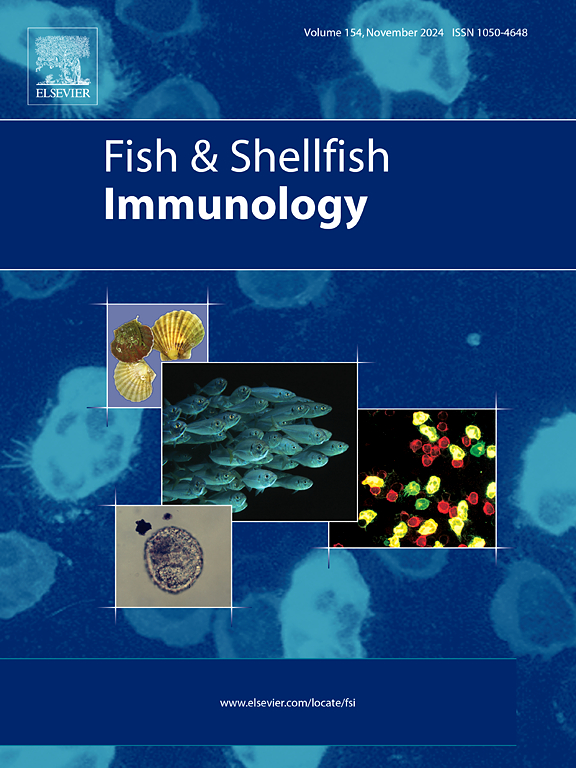花生四烯酸5-脂氧合酶的鉴定及其在刺参免疫中的作用。
IF 4.1
2区 农林科学
Q1 FISHERIES
引用次数: 0
摘要
大量研究表明,花生四烯酸5-脂氧合酶(ALOX-5)通过催化花生四烯酸(ARA)生成白三烯,在调节一系列生理和病理过程中起作用。成功扩增出Apostichopus japonicus ALOX-5的编码序列(Aj-ALOX-5),得到2028 bp的ORF序列,编码674个氨基酸。与其他5-脂氧合酶的氨基酸序列比较发现,Aj-ALOX-5具有该酶家族的n端“PLAT结构域”和c端“脂氧合酶结构域”特征。酶活性位点和Ca2 +结合位点表现出高度的保守性。系统进化树还表明,Aj-ALOX-5与海星5-脂氧合酶亲缘关系密切。重组Aj-ALOX-5 (rAj-ALOX-5)通过工程菌外源表达获得,用Ni2+-NTA纯化。观察到rAj-ALOX-5能催化ARA生成5-HPETE和LTA4,表明Aj-ALOX-5蛋白属于5-脂氧合酶家族。qRT-PCR结果显示Aj-ALOX-5广泛分布于组织中。此外,在应激条件下,脾脏弧菌诱导的Aj-ALOX-5 mRNA和5-HETE的表达均显著上调。最佳咖啡酸对Aj-ALOX-5表达的抑制显著提高了海参的死亡率。进一步研究发现,5-HPETE和NF-κB I的产生也被显著抑制。可以推测Aj-ALOX-5通过介导NF-κB I通路在海参免疫应答中发挥重要作用。本文章由计算机程序翻译,如有差异,请以英文原文为准。
Identification of the arachidonic acid 5-lipoxygenase and its function in the immunity of Apostichopus japonicus
A number of studies have been demonstrated that arachidonate 5-lipoxygenase (ALOX-5) plays a role in regulating a range of physiological and pathological processes through the catalysis of leukotriene formation from arachidonic acid (ARA). The coding sequence of ALOX-5 from Apostichopus japonicus (Aj-ALOX-5) was successfully amplified, resulting in a 2028 bp ORF sequence that encodes 674 amino acids. A comparison of the amino acid sequence with those of other 5-lipoxygenases revealed that Aj-ALOX-5 has the N-terminal "PLAT domain" and C-terminal "lipoxygenase structural domain" characteristic of this enzyme family. The enzyme activity sites and Ca2⁺-binding sites exhibited high levels of conservation. The phylogenetic tree also indicated that Aj-ALOX-5 was closely related to starfish 5-lipoxygenase. The recombinant Aj-ALOX-5 (rAj-ALOX-5) was obtained through the exogenous expression of an engineered bacterium and purified using Ni2+-NTA. rAj-ALOX-5 was observed to catalyze ARA to produce 5-HPETE and LTA4, which indicated that the Aj-ALOX-5 protein belonged to the 5-lipoxygenase family. qRT-PCR demonstrated that Aj-ALOX-5 is widely distributed in tissues. Furthermore, the Aj-ALOX-5 mRNA and the production of 5-HETE were found to be significantly up-regulated in response to stress induced by Vibrio splendidus. Inhibition of Aj-ALOX-5 expression by the optimal caffeic acid resulted in a significant increase in mortality rates of sea cucumbers. Further investigation revealed that the production of 5-HPETE and NF-κB I was also significantly suppressed. It can be hypothesized that Aj-ALOX-5 plays an important role in the immune response of sea cucumbers by mediating the NF-κB I pathway.
求助全文
通过发布文献求助,成功后即可免费获取论文全文。
去求助
来源期刊

Fish & shellfish immunology
农林科学-海洋与淡水生物学
CiteScore
7.50
自引率
19.10%
发文量
750
审稿时长
68 days
期刊介绍:
Fish and Shellfish Immunology rapidly publishes high-quality, peer-refereed contributions in the expanding fields of fish and shellfish immunology. It presents studies on the basic mechanisms of both the specific and non-specific defense systems, the cells, tissues, and humoral factors involved, their dependence on environmental and intrinsic factors, response to pathogens, response to vaccination, and applied studies on the development of specific vaccines for use in the aquaculture industry.
 求助内容:
求助内容: 应助结果提醒方式:
应助结果提醒方式:


